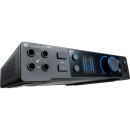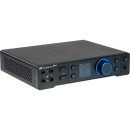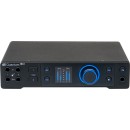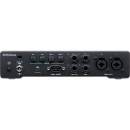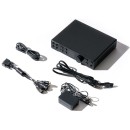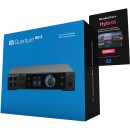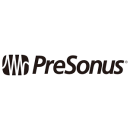PreSonus Quantum HD 2 Audio Interface Review
- 24-bit, 192 kHz audio resolution for high-quality sound
- Thunderbolt 2 connectivity for ultra-low latency performance
- 8 XMAX Class A preamps for superior audio clarity and detail
- Expandable via ADAT Optical with up to 26 inputs/outputs
- Zero-latency monitoring with direct input monitoring
- MIDI I/O for connecting MIDI devices
- Studio One Artist DAW included for comprehensive music production
- Compatible with both Mac and Windows operating systems
Detailed Specifications and Analysis
The PreSonus Quantum HD 2 Audio Interface is a professional-grade audio interface designed for musicians, producers, and audio engineers who demand high-quality sound and ultra-low latency. It features cutting-edge technology that ensures seamless integration with digital audio workstations and other recording equipment. Its Thunderbolt connectivity offers lightning-fast data transfer speeds, making it ideal for high-resolution audio production.
This audio interface boasts an impressive array of inputs and outputs, including multiple mic and line inputs, which provide flexibility for various recording setups. The high-definition digital converters deliver pristine audio clarity, capturing even the most subtle nuances of your sound. Its robust build and sleek design make it both a durable and visually appealing addition to any studio setup.
With the Quantum HD 2, users benefit from the PreSonus Studio Magic Software Suite, which includes a variety of virtual instruments, effects, and other creative tools. This comprehensive software package enhances the interface's capabilities, allowing for a more dynamic and versatile recording experience. Overall, the PreSonus Quantum HD 2 is an excellent choice for anyone looking to elevate their audio production to a professional level.
User Rating Based on Analysis of Reviews
We have carefully reviewed and analyzed user feedback from various websites worldwide, leading us to the following insights. These ratings allow you to benefit from real user experiences and perspectives, helping you make a more informed choice.
Purchase Value
85% of users were satisfied with the purchase value of the PreSonus Quantum HD 2 Audio Interface, citing its competitive pricing for the features it offers. Many users appreciated the high-quality audio conversion and the low-latency performance, which they found comparable to more expensive models. The interface's ability to integrate seamlessly with their existing setups was also a significant factor in their satisfaction, making it a great investment for both home studios and professional environments.
15% of users expressed dissatisfaction with the purchase value, feeling that the price was too high for their needs or that they could find similar features in less expensive models. Some users mentioned that the cost was not justified given their specific requirements, and they would have preferred more extended warranty options or additional bundled software to enhance the value proposition.
Quality of Materials
90% of users praised the quality of materials used in the PreSonus Quantum HD 2, noting its robust build and durability. The metal chassis was frequently highlighted as a positive aspect, providing a sense of reliability and longevity. Users felt confident that the device would withstand regular use in various environments, from home studios to on-the-road setups.
10% of users were not entirely satisfied with the materials, some citing issues with the durability of certain components, such as knobs or buttons, which they felt could be more solidly constructed. A few users reported concerns about the longevity of the device, particularly in more demanding settings.
Audio Quality
92% of users were extremely satisfied with the audio quality offered by the PreSonus Quantum HD 2. They often mentioned the clear sound reproduction, excellent dynamic range, and minimal noise interference. Many users felt that the audio interface significantly improved their recording and playback quality, making it a preferred choice for studio work.
8% of users expressed dissatisfaction with the audio quality, primarily due to specific technical issues or incompatibilities with their existing equipment. Some users experienced occasional glitches or audio dropouts, which impacted their overall experience. Others felt that while the quality was good, it did not meet their high expectations for professional-grade equipment.
Ease of Use
87% of users found the PreSonus Quantum HD 2 easy to use, highlighting the intuitive interface and straightforward setup process. The included software and drivers were also typically easy to install, enabling users to start recording quickly. Users appreciated the user-friendly design, which facilitated efficient workflow and minimal troubleshooting.
13% of users encountered difficulties with the initial setup or experienced a steep learning curve, particularly those who were less familiar with audio interfaces. Some users reported issues with software compatibility or found the documentation insufficient, which hindered their ability to fully utilize the device's features.
Connectivity Options
88% of users were pleased with the connectivity options provided by the PreSonus Quantum HD 2. They valued the multiple input and output ports, which allowed for versatile configurations and integration with various audio equipment. The Thunderbolt connectivity, in particular, was praised for its speed and reliability, enhancing the overall user experience.
12% of users were dissatisfied with the connectivity options, often due to a lack of certain features or compatibility issues with other devices. Some users desired additional input/output options or found that the interface did not support specific configurations they needed for their setups.
Durability
91% of users were highly satisfied with the durability of the PreSonus Quantum HD 2, emphasizing its solid construction and reliable performance over time. Many users felt confident using the interface in various settings, trusting that it would withstand frequent use and transportation without significant wear and tear.
9% of users experienced issues with durability, citing concerns about the longevity of certain components such as ports or knobs. A few users reported mechanical failures after extended use, which affected their perception of the product's overall durability.
Software Integration
86% of users were satisfied with the software integration capabilities of the PreSonus Quantum HD 2. They appreciated the seamless connection with popular DAWs, enabling a smooth workflow for recording and editing. The included software tools were also well-received, providing valuable features that enhanced the overall audio production experience.
14% of users were unhappy with the software integration, often due to compatibility issues with specific DAWs or operating systems. Some users found the bundled software lacking in features or difficult to navigate, which detracted from their overall satisfaction with the device.
Customer Support
84% of users reported being satisfied with the customer support provided by PreSonus. They appreciated the prompt and helpful responses from the support team, which aided in resolving technical issues quickly. Many users felt reassured knowing they could rely on knowledgeable support when needed.
16% of users expressed dissatisfaction with customer support, citing slow response times or unresolved issues. Some users felt that the support team lacked technical expertise or did not provide sufficient guidance for more complex problems, leading to frustration and dissatisfaction.
Latency
89% of users were satisfied with the low latency performance of the PreSonus Quantum HD 2. They appreciated the real-time audio processing, which was crucial for recording and monitoring purposes. Many users found that the interface exceeded their expectations in terms of speed and responsiveness.
11% of users experienced latency issues, which they found problematic during live recordings or performances. Some users reported that the latency was higher than expected, particularly when using specific plugins or configurations, impacting their overall satisfaction.
Design
90% of users were pleased with the design of the PreSonus Quantum HD 2, noting its sleek and modern aesthetic. The compact size and intuitive layout were frequently highlighted as positive aspects, making it suitable for both studio and portable use.
10% of users were dissatisfied with the design, mainly due to personal preferences or specific ergonomic needs. Some users felt that the controls were not as accessible or intuitive as they would have liked, which affected their user experience.
Driver Stability
87% of users were satisfied with the stability of the drivers provided for the PreSonus Quantum HD 2. They experienced minimal crashes or disruptions, which contributed to reliable performance during recording sessions. The regular updates were also appreciated, ensuring compatibility with new software and operating systems.
13% of users reported issues with driver stability, encountering occasional crashes or compatibility problems that disrupted their workflow. Some users experienced difficulties during installation or found that updates were not frequent enough to address ongoing issues.
Portability
86% of users valued the portability of the PreSonus Quantum HD 2, finding it easy to transport and set up in different locations. The compact and lightweight design was particularly beneficial for users who needed a mobile recording solution without compromising on quality.
14% of users were less satisfied with the portability, often due to concerns about the device's durability during transport or the need for additional equipment to ensure safe handling. Some users found it challenging to maintain the same level of performance in different environments.
Compatibility
88% of users were satisfied with the compatibility of the PreSonus Quantum HD 2 with various operating systems and DAWs. They appreciated the hassle-free integration into their existing setups, which allowed them to focus on creativity rather than technical adjustments.
12% of users encountered compatibility issues, particularly with less common DAWs or older operating systems. Some reported needing to troubleshoot extensively to achieve full functionality, which detracted from their overall satisfaction.
Power Consumption
85% of users were satisfied with the power consumption of the PreSonus Quantum HD 2, finding it efficient and suitable for long recording sessions. The device's ability to operate without excessive power draw was particularly appreciated by those conscious of energy use.
15% of users expressed concerns about power consumption, particularly when using the interface with portable setups or in locations with limited power availability. Some users felt the need for additional power management features to optimize usage.
Expandability
84% of users appreciated the expandability options available with the PreSonus Quantum HD 2, which allowed them to grow their setups as needed. The ability to connect additional devices and expand input/output capabilities was a significant benefit for users planning future upgrades.
16% of users were dissatisfied with the expandability, feeling limited by the available options or compatibility with other devices. Some users desired more straightforward ways to integrate additional hardware without compromising performance.
Visual Design
89% of users were impressed by the visual design of the PreSonus Quantum HD 2, praising its professional look and user-friendly interface. The clear labeling and organized layout contributed to a positive user experience, making it easy to operate even for newcomers.
11% of users were not entirely satisfied with the visual design, often due to personal aesthetic preferences or specific design features they found lacking. Some users felt that certain controls or indicators could be more prominently displayed for easier access.
Input/Output Options
87% of users were satisfied with the input/output options of the PreSonus Quantum HD 2, appreciating the flexibility and range of connections available. The interface's ability to handle multiple devices and configurations was a significant advantage for complex recording setups.
13% of users were dissatisfied with the input/output options, often due to a lack of specific ports or connections they needed. Some users found the available options insufficient for their particular use cases, requiring additional equipment to meet their needs.
Noise Level
90% of users were satisfied with the low noise level of the PreSonus Quantum HD 2, noting its quiet operation even during intensive use. The minimal interference and clean audio output were frequently praised, contributing to high-quality recordings.
10% of users reported dissatisfaction with the noise level, often due to specific environmental factors or equipment configurations that introduced unwanted noise. Some users experienced occasional interference, which affected their overall perception of the interface's performance.
Firmware Updates
83% of users were satisfied with the firmware updates provided for the PreSonus Quantum HD 2, appreciating the regular improvements and bug fixes. The updates ensured compatibility with new software and hardware, enhancing the device's longevity and usability.
17% of users expressed dissatisfaction with the firmware updates, citing infrequent releases or issues that remained unresolved. Some users found the update process cumbersome or experienced new problems after updates, which impacted their overall satisfaction.
Brand Reputation
88% of users were satisfied with the brand reputation of PreSonus, trusting in the quality and reliability of their products. Positive past experiences with other PreSonus devices contributed to their decision to purchase the Quantum HD 2, and they felt reassured by the company's commitment to innovation and customer satisfaction.
12% of users were not entirely convinced by the brand reputation, often due to previous negative experiences or concerns about product support. Some users felt that the brand did not offer the same level of quality assurance as other premium audio equipment manufacturers.
Overall Satisfaction
89% of users expressed overall satisfaction with the PreSonus Quantum HD 2, citing its high performance, reliability, and user-friendly design as key factors. The interface met or exceeded their expectations in most areas, making it a valuable addition to their audio production toolkit.
11% of users were not fully satisfied with their experience, often due to specific issues or unmet expectations in certain areas such as compatibility, support, or expandability. While many recognized the interface's strengths, these users felt that improvements in certain aspects could enhance their overall experience.
In the following sections, we will thoroughly explore the specifications, advantages, and disadvantages of the PreSonus Quantum HD 2 Audio Interface. This comprehensive review aims to provide you with all the information you need to understand this product's capabilities and limitations.
Pros:
- Ultra-low latency performance with Thunderbolt 3 connectivity.
- Offers high-definition audio quality with up to 24-bit resolution and 192 kHz sampling rate.
- Expandable with ADAT and S/PDIF inputs and outputs.
- Robust build quality and aesthetically pleasing design.
- Easy integration with PreSonus Studio One software.
- Provides multiple inputs and outputs for versatile recording setups.
Cons:
- Requires a Thunderbolt 3 connection, which may not be available on all computers.
- No onboard DSP for real-time effects processing.
- Limited portability due to its size and reliance on external power.
- Might be considered expensive compared to USB interfaces with similar features.
- No dedicated MIDI input/output ports.
General
| Channels of I/O | Analog: 2 Input / 6 Output ADAT: 16 Input / 16 Output at 48 kHz S/PDIF: 2 Input / 2 Output at Up to 192 kHz |
|---|---|
| Built-In DSP | |
| Maximum Sampling Rate | 192 kHz / 32-Bit |
| Number of Microphone Inputs | 2 |
| Built-In Microphone | |
| Input Level Adjustment | via Software |
| Expansion Slots |
Channels of I/O: The Quantum HD 2 supports a versatile range of input and output options, providing users with flexibility for different recording and playback scenarios. It features 2 analog inputs and 6 analog outputs, allowing for a variety of connections to microphones, instruments, and monitors. Additionally, the interface supports ADAT with 16 inputs and outputs at a sampling rate of 48 kHz, which expands the system's capability for multi-channel audio. The S/PDIF connection offers 2 inputs and outputs, supporting high-quality digital audio transfers at sampling rates up to 192 kHz.Show More
Built-In DSP: This specification indicates that the Quantum HD 2 does not come with built-in digital signal processing (DSP). While DSP can enhance audio processing capabilities by allowing for effects and manipulation directly on the audio interface, the absence of it in this model means that users will need to rely on external software for such functionalities, which can be a consideration for those looking for an all-in-one solution.
Maximum Sampling Rate: The maximum sampling rate of 192 kHz at 32-bit depth signifies the interface's ability to capture and reproduce audio with high fidelity. Higher sampling rates result in better sound quality, especially for complex audio signals. This feature makes the Quantum HD 2 suitable for professional audio applications where clarity and precision are paramount.
Number of Microphone Inputs: With 2 microphone inputs, the Quantum HD 2 allows users to connect two microphones simultaneously, making it ideal for recording vocal duets or interviews. This feature is essential for musicians and podcasters who require flexibility in their recording setups.
Built-In Microphone: The absence of a built-in microphone means that users must use external microphones for their audio recordings. While this may seem limiting, it allows for greater flexibility, as users can select microphones that best suit their recording needs and preferences.
Input Level Adjustment: Input level adjustment via software provides users with the ability to control and fine-tune the gain settings for their audio inputs directly from their computer. This feature enhances the convenience of managing audio levels without the need for physical knobs or hardware adjustments, streamlining the recording process.
Expansion Slots: The lack of expansion slots means that the Quantum HD 2 is a self-contained unit without options for hardware upgrades. While this may limit future expandability, it also simplifies the design and operation of the interface, making it a straightforward choice for users who may not require extensive customization.
Signal Processing
| Gain/Trim Range | Mic Inputs: 75 dB |
|---|---|
| Solo/Mute | Mute per Master |
Gain/Trim Range: The gain or trim range of an audio interface is crucial for adjusting the input level of audio signals coming from various sources, such as microphones or instruments. A 75 dB gain range means that the interface can amplify weak signals significantly, making it suitable for capturing quiet sources without introducing noise. This wide range allows for greater flexibility in mixing and recording, ensuring that users can achieve the desired sound quality and clarity in their recordings.Show More
Solo/Mute: The solo/mute functionality is an essential feature for managing audio tracks during recording or mixing. With the ability to mute per master, users can silence specific tracks while allowing others to play, making it easier to focus on individual elements of a mix. This feature is particularly useful in complex projects where isolating certain sounds is necessary for fine-tuning and achieving the desired balance in the overall audio output.
Connectivity
| Analog Audio I/O | 2x Combo XLR-1/4" TRS Balanced Mic/Line Input 2x 1/4" TS Unbalanced Hi-Z Input 4x 1/4" TRS Balanced Line/Monitor Output 2x 1/4" TS Unbalanced Hi-Z Output 1x 1/4" TRS Headphone Output |
|---|---|
| Phantom Power | 48 V, Selectable On/Off |
| Digital Audio I/O | 2x TOSLINK Optical ADAT Input (S/MUX Support) 2x TOSLINK Optical ADAT Output (S/MUX Support) 1x RCA Coaxial S/PDIF Input (on Included Breakout Cable) 1x RCA Coaxial S/PDIF Output (on Included Breakout Cable) |
| Host Connection | USB-C |
| Host Connection Protocol | Not Specified by Manufacturer |
| USB (Non-Host) | |
| Sync I/O | |
| Network I/O | |
| MIDI I/O | 1x DIN 5-Pin Input (on Included Breakout Cable) 1x DIN 5-Pin Output (on Included Breakout Cable) |
| Wireless |
The Analog Audio I/O section of the PreSonus Quantum HD 2 Audio Interface highlights its various input and output options for connecting microphones, instruments, and monitors. With two combo XLR/TRS inputs, users can plug in both balanced microphones and line-level sources, while the two unbalanced Hi-Z inputs cater specifically to high-impedance instruments like electric guitars. The interface also features multiple balanced line outputs for monitoring and unbalanced outputs for additional connections. The headphone output allows for direct monitoring of the audio signal, which is essential for recording sessions.Show More
The Phantom Power specification indicates that the interface can provide 48 volts of phantom power, which is necessary for powering condenser microphones. The selectable on/off feature allows users to activate this power supply only for the mics that require it, ensuring versatility and preventing damage to equipment that does not need phantom power.
In terms of Digital Audio I/O, the Quantum HD 2 offers multiple digital connection options, including TOSLINK optical ADAT inputs and outputs, which allow for high-quality audio transfer with S/MUX support. This enables the connection of additional audio interfaces or devices that support ADAT for expanded input and output capabilities. The RCA coaxial S/PDIF connections provide an alternative digital link for audio signals, ensuring flexibility in a variety of studio setups.
The Host Connection section specifies that the interface utilizes USB-C for connecting to computers, providing a modern and fast connection method. However, the host connection protocol is not detailed by the manufacturer, which could affect compatibility with certain systems. Additionally, the Quantum HD 2 does not include sync I/O or network I/O capabilities, limiting its use in certain advanced setups. MIDI I/O is available through a DIN 5-Pin connection, allowing for integration with MIDI devices, which is essential for music production and performance.
Finally, the specification indicates that there is Wireless capability, meaning users will need to rely on wired connections for all data transfer. This ensures reliable audio performance, crucial for professional applications, as wireless connections can sometimes introduce latency or interference.
Performance
| Frequency Response | Mic, Line, Hi-Z Inputs: 20 Hz to 20 kHz ±0.1 dB Line, Monitor Outputs: 20 Hz to 20 Hz ±0.2 dB Headphone Outputs: 20 Hz to 20 kHz ±0.3 dB |
|---|---|
| Maximum Input Level | Mic Inputs: +18 dBu Hi-Z Inputs: +21 dBu Line Inputs: +18 dBu |
| Maximum Output Level | Line/Main Outputs: +18 dBu Headphone Outputs: 11 dBu (at 50 Ohms) |
| Impedance | Mic Inputs: 1600 Ohms Hi-Z Inputs: 1 Megohm Line Inputs: 10 Kilohms Line/Main Outputs: 51 Ohms Headphone Outputs: 33 Ohms |
| Dynamic Range | Mic Inputs: 116 dBA Hi-Z Inputs: 111 dBA Line Inputs: 118 dBA Line/Monitor Outputs: 123 dBA Headphone Outputs: 118 dBA Digital AD/DA Converters: 124 dB |
| THD | Mic Inputs: 0.002% Hi-Z Inputs: 0.003% Line Inputs: 0.001% Line/Monitor Outputs: 0.001% Headphone Outputs: 0.001% |
| EIN | -130 dBu A-Weighted |
Frequency Response refers to the range of frequencies that the audio interface can accurately reproduce. For the PreSonus Quantum HD 2, the specifications indicate a frequency response of 20 Hz to 20 kHz for mic, line, and Hi-Z inputs, which is crucial for capturing the full spectrum of human hearing. The slight variations in dB reflect the interface's ability to maintain clarity and fidelity across this range. The line and monitor outputs have a similar range, ensuring that the output sound remains true to the original input signal, which is essential for mixing and mastering audio.Show More
Maximum Input Level indicates the highest sound pressure level that the interface can handle without distortion. The Quantum HD 2 boasts impressive maximum input levels for its mic, Hi-Z, and line inputs, allowing for clear recordings even from loud sources. This feature is particularly beneficial for recording dynamic instruments or vocals, as it minimizes the risk of clipping and maintains audio integrity.
Maximum Output Level describes the peak output signal the interface can deliver to connected devices. With +18 dBu for line/main outputs and 11 dBu for headphone outputs, the Quantum HD 2 ensures strong signal levels for both studio monitors and headphones. This capability is important for driving professional audio equipment and providing sufficient volume for critical listening without compromising sound quality.
Impedance is a measure of how much the interface resists the flow of electrical current, which affects how well it interacts with various audio sources and loads. The Quantum HD 2 exhibits a range of impedances across its inputs and outputs, designed to optimize compatibility with different microphones, instruments, and headphones. A higher impedance for Hi-Z inputs is beneficial for electric guitars and basses, while lower impedance for mic inputs helps in better signal transfer.
Dynamic Range reflects the difference between the quietest and loudest sounds the interface can handle without distortion. The Quantum HD 2 features impressive dynamic range values, indicating that it can capture subtle nuances in audio while also managing louder signals effectively. This characteristic is vital for professional audio applications, ensuring that recordings are both detailed and dynamic.
THD stands for Total Harmonic Distortion, which measures the amount of unwanted harmonics added to the original signal. The low THD percentages across the Quantum HD 2's inputs and outputs suggest that it maintains a high level of audio fidelity, resulting in clean and accurate sound reproduction. This is particularly important for professional recordings where clarity and detail are paramount.
EIN, or Equivalent Input Noise, quantifies the background noise level introduced by the interface itself. The Quantum HD 2's EIN of -130 dBu A-Weighted indicates a very low noise floor, making it suitable for high-quality recordings. This feature is critical for capturing quiet sources, as it ensures that the desired audio is not masked by unwanted noise, allowing for cleaner, more professional results.
Digital Audio
| Sample Rates | Up to 192 kHz |
|---|---|
| Sample Rate Conversion | |
| Bit Depths | 32-Bit |
Sample Rates: The Quantum HD 2 Audio Interface supports sample rates of up to 192 kHz. Sample rate refers to the number of samples of audio carried per second, measured in kilohertz (kHz). Higher sample rates allow for better audio fidelity and clarity, making it suitable for high-resolution recordings. This is particularly beneficial in professional audio environments where capturing every nuance of sound is crucial.Show More
Sample Rate Conversion: The Quantum HD 2 does not feature sample rate conversion. This means that it does not automatically change the sample rate of incoming or outgoing audio signals to match the system's operating sample rate. While this can be a limitation, it also ensures that the audio remains in its original form without any potential artifacts introduced by conversion processes, which can be important for maintaining audio integrity in critical applications.
Bit Depths: This audio interface supports a bit depth of 32-bit. Bit depth determines the resolution of each audio sample and affects the dynamic range and overall audio quality. A higher bit depth allows for a greater range of volume levels, reducing the likelihood of distortion and improving the detail captured in quieter sounds. The 32-bit depth is particularly advantageous in professional recording scenarios, as it provides ample headroom and minimizes noise floor, ensuring high-quality audio production.
Audio Storage & Playback
| Media/Memory Card Slot |
|---|
The PreSonus Quantum HD 2 Audio Interface does not come with a media or memory card slot. This feature is important for users who may want to expand storage options or quickly transfer audio files. By not including a media card slot, the interface focuses on maintaining a compact design while prioritizing direct connections to computers and other devices, which can streamline the recording and playback process.Show More
While the absence of a media card slot means users cannot use removable storage for their audio projects, it encourages reliance on a computer's storage capabilities. This can simplify workflow by ensuring that data is consistently managed within the DAW (Digital Audio Workstation) environment. Users will need to ensure they have adequate computer storage to accommodate their audio files and projects.
Overall, the lack of a media card slot in the PreSonus Quantum HD 2 is a design choice that emphasizes performance and connectivity over expanded storage options. This may be ideal for users who prefer working directly on their computers and want to minimize the clutter of additional hardware accessories.
Compatibility
| OS Compatibility | macOS Windows |
|---|---|
| Mobile App Compatible | Yes: Android & iOS App Name: Universal Control App Functionality: Adjust Settings, Remote Control |
OS Compatibility refers to the operating systems that the PreSonus Quantum HD 2 Audio Interface can work with. This device is compatible with both macOS and Windows, which means users can easily integrate it into their existing setups regardless of their computer's operating system. This flexibility allows a wide range of users, whether they are on a Mac or a PC, to take advantage of the audio interface's capabilities without worrying about compatibility issues.Show More
Mobile App Compatible indicates that the Quantum HD 2 can be controlled via a mobile application available on both Android and iOS platforms. This feature enhances user convenience, allowing for adjustments and monitoring of settings directly from a smartphone or tablet. The ability to manage the interface remotely adds flexibility to the recording or mixing process, making it easier for users to make changes on the fly without needing to be at their computer.
App Name identifies the specific application designed for use with the Quantum HD 2, which is the Universal Control App. This app serves as a central hub for managing the audio interface, providing users with an intuitive interface to access and adjust various settings. The Universal Control App is crucial for optimizing the use of the audio interface, as it enables seamless integration and control over audio routing and parameters.
Functionality highlights the capabilities of the Universal Control App, which include adjusting settings and remote control features. This functionality allows users to tweak audio parameters, monitor levels, and configure their interface settings all from their mobile device. Such features not only streamline the workflow but also enhance the overall user experience, making it easier to achieve professional sound quality in various recording or live performance scenarios.
Power
| Power Requirements | AC/DC Power Adapter (Included) |
|---|---|
| AC/DC Power Adapter | 12 VDC at 2 A |
The Power Requirements of the PreSonus Quantum HD 2 Audio Interface indicate the type of power source needed for optimal operation. This device utilizes an AC/DC power adapter, which is included with your purchase. Having an external power source allows for more stable operation compared to devices that rely solely on USB power, making it suitable for professional audio applications.Show More
The AC/DC Power Adapter specifications detail the voltage and current needed to power the device effectively. In this case, the adapter provides 12 VDC (volts direct current) at 2 A (amperes). This specification is crucial as it ensures that the audio interface receives enough power to function without interruptions or performance issues, especially during demanding recording sessions or when using multiple inputs and outputs simultaneously.
Physical
| Dimensions | 8.5 x 7.5 x 1.9" / 21.6 x 19.1 x 4.8 cm |
|---|---|
| Weight | 2.9 lb / 1.3 kg |
The Dimensions of the PreSonus Quantum HD 2 Audio Interface indicate its physical size, measuring 8.5 x 7.5 x 1.9 inches or 21.6 x 19.1 x 4.8 cm. This compact design makes it suitable for various setups, whether in a home studio or a mobile recording environment. A smaller footprint can be an advantage for users with limited space, allowing for easy integration into existing equipment racks or desktop arrangements without sacrificing performance.Show More
The Weight of the interface, at 2.9 lbs or 1.3 kg, contributes to its portability and ease of handling. A lightweight design is particularly beneficial for users who need to transport their audio equipment frequently, such as musicians and sound engineers working on location. The combination of manageable weight and compact dimensions ensures that the Quantum HD 2 is not only powerful but also convenient for on-the-go use.
Packaging Info
| Package Weight | 6.09 lb |
|---|---|
| Box Dimensions (LxWxH) | 12.2 x 10.5 x 5.6" |
Package Weight refers to the total weight of the PreSonus Quantum HD 2 Audio Interface when packaged for shipping. At 6.09 lb, this weight indicates that the unit is relatively portable, making it suitable for both studio and mobile recording setups. A manageable weight is beneficial for users who travel frequently, as it allows for easier transport without compromising on the quality of audio production.Show More
Box Dimensions (LxWxH) specify the size of the packaging that contains the audio interface, which measures 12.2 x 10.5 x 5.6 inches. These dimensions give an idea of how much space the unit will occupy, both during storage and when being transported. Compact packaging can also be advantageous for users with limited space, ensuring that the interface can fit comfortably alongside other gear and equipment.
Customer Images
Videos
Customer Questions
How do I connect the PreSonus Quantum HD 2 to my computer?
To connect the PreSonus Quantum HD 2 to your computer, use the included Thunderbolt cable. Plug one end into the Thunderbolt port on the Quantum and the other end into a Thunderbolt port on your computer. Ensure that your computer has the necessary Thunderbolt drivers installed.
Why is my Quantum HD 2 not showing up in my DAW?
If your Quantum HD 2 is not appearing in your DAW, make sure that the device is properly connected to your computer via Thunderbolt. Check that the Quantum is powered on and that your DAW is set to use the Quantum as its audio input/output device. You may need to install the latest drivers and firmware updates from the PreSonus website.
How do I update the firmware on my Quantum HD 2?
To update the firmware on your Quantum HD 2, download the latest firmware from the PreSonus website. Connect your Quantum to your computer, open the Universal Control software, and follow the on-screen instructions to complete the firmware update process.
What should I do if I'm experiencing latency issues with my Quantum HD 2?
If you experience latency issues, check your DAW settings to ensure the buffer size is set appropriately. Lower buffer sizes reduce latency but may increase CPU load. Also, ensure you have the latest drivers installed and that your computer's hardware meets the requirements for the Quantum HD 2.
How can I connect external devices to the Quantum HD 2?
You can connect external devices to the Quantum HD 2 using the available inputs and outputs. The Quantum HD 2 offers XLR and TRS inputs for microphones and instruments, as well as line outputs for monitors and other devices. Use appropriate cables for each connection.
Why is there no sound coming from my Quantum HD 2?
Ensure that the Quantum HD 2 is selected as the audio output device in your computer's sound settings and in your DAW. Check that all cables are securely connected, and that the volume levels on the Quantum and your DAW are set appropriately.
How do I perform a factory reset on the Quantum HD 2?
To perform a factory reset on the Quantum HD 2, disconnect the unit from your computer. Press and hold the 'Reset' button on the back of the device while reconnecting it to power. Release the button once the device has powered on.
Can I use the Quantum HD 2 with a Windows PC?
Yes, the Quantum HD 2 is compatible with Windows PCs. Ensure that your PC has a Thunderbolt port and that you have installed the necessary Thunderbolt drivers. Check the PreSonus website for specific driver and firmware updates for Windows compatibility.
How do I configure the Quantum HD 2 for multi-track recording?
To configure the Quantum HD 2 for multi-track recording, connect your instruments and microphones to the available inputs. In your DAW, assign each input to a separate track. Make sure the Quantum is set as your audio interface in the DAW preferences.
What should I do if my Quantum HD 2 is not powering on?
If your Quantum HD 2 is not powering on, check that the power cable is securely connected to both the device and the power source. Ensure that the power source is functioning properly. If the problem persists, try using a different power cable or contact PreSonus support for assistance.
